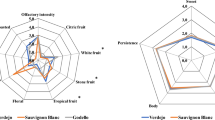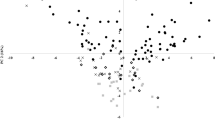Abstract
Predicate wines are sweet natural wines that in good years and appropriate conditions of ripening grapes on the vine, their degree of overripe and time of harvest, achieve a special quality. The aroma compounds of predicate wines from Croatia have not yet been studied. The predicate commercial wines (selected harvest wines and ice wines) of four different grape cultivars (‘Welschriesling’, ‘Kerner’, ‘Gewürztraminer’, ‘Chardonnay’) more than 10 years old were examined by GC–MS. Aroma compounds were extracted by solid-phase extraction. The results show that during ageing, sotolon and furfural concentrations are increased. Generally, higher concentrations of 1-octen-3-ol were noticed in selected harvest wines what may be connected with the metabolic activity of Botrytis cinerea. Linalool, β-damascenone, α-ionone, β-ionone, γ-nonalactone, sotolon, cis-rose oxide and 1-octen-3-ol had the greatest contribution to the overall aroma composition (odour activity value OAV ˃1). These results increase the understanding of aroma composition and the influence of ageing on selected harvest white wines and ice wines.


Similar content being viewed by others
References
Ribéreau-Gayon P, Dubourdieu D, Donèche B, Lonvaud A (2006) Handbook of enology: the microbiology of wine and vinifications, vol 1. Wiley, New York
Costantini V, Bellincontro A, De Santis D, Botondi R, Mencarelli F (2006) Metabolic changes of Malvasia grapes for wine production during postharvest drying. J Agric Food Chem 54(9):3334–3340. doi:10.1021/jf0531171
Genovese A, Gambuti A, Piombino P, Moio L (2007) Sensory properties and aroma compounds of sweet Fiano wine. Food Chem 103(4):1228–1236. doi:10.1016/j.foodchem.2006.10.027
Bellincontro A, Nicoletti I, Valentini M, Tomas A, De Santis D, Corradini D, Mencarelli F (2009) Integration of nondestructive techniques with destructive analyses to study postharvest water stress of winegrapes. Am J Enol Vitic 60(1):57–65
Ziraldo D, Kaiser K (2007) Icewine: extreme winemaking. Key Porter Books, Toronto
Schreiner J (2001) Icewine—the complete story. Warwick Publishing, Toronto
Fenoll J, Manso A, Hellin P, Ruiz L, Flores P (2009) Changes in the aromatic composition of the Vitis vinifera grape Muscat Hamburg during ripening. Food Chem 114(2):420–428. doi:10.1016/j.foodchem.2008.09.060
Marais J (1987) Terpene concentrations and wine quality of vitis-vinifera l cv gewurztraminer as affected by grape maturity and cellar practices. Vitis 26(4):231–245
Gunata YZ, Bayonove CL, Baumes RL, Cordonnier RE (1985) The aroma of grapes Localisation and evolution of free and bound fractions of some grape aroma components cv Muscat during first development and maturation. J Sci Food Agric 36(9):5
Franco M, Peinado RA, Medina M, Moreno J (2004) Off-vine grape drying effect on volatile compounds and aromatic series in must from Pedro Ximenez grape variety. J Agric Food Chem 52(12):3905–3910. doi:10.1021/jf0354949
Ribéreau-Gayon P, Glories Y, Maujean A, Dubourdieu D (2006) Handbook of enology: the chemistry of wine stabilization and treatments, vol 2. 2nd edn. Wiley, New York
Sulser H, Depizzol J, Buchi W (1967) A probable flavoring principle in vegetable-protein hydrolysates. J Food Sci 32(6):611–615. doi:10.1111/j.1365-2621.1967.tb00846.x
Martin B, Etievant PX, Lequere JL, Schlich P (1992) More clues about sensory impact of sotolon in some flor sherry wines. J Agric Food Chem 40(3):475–478. doi:10.1021/jf00015a023
Guichard E, Pham TT, Etievant P (1993) Quantitative-determination of sotolon in wines by high-performance liquid-chromatography. Chromatographia 37(9–10):539–542. doi:10.1007/bf02275793
Masuda MOE, Nishimura KC, Yunome H (1984) Identification of 4,5-dimethyl-3-hydroxy-2(5H)-furanone (Sotolon) and ethyl 9-hydroxynonanoate in botrytised wine and evaluation of the roles of compounds characteristic of it. Agric Biol Chem 48(11):3
Sponholz WRHT (1994) 4, 5-Dimethyl-3-hydroxy-2(5H)-furanon (Sotolon), ein Botrytisindikator? Wein-Wissenshaft 49:2
Collin S, Nizet S, Bouuaert TC, Despatures PM (2012) Main odorants in Jura flor-sherry wines, Relative contributions of sotolon, abhexon, and theaspirane-derived compounds. J Agric Food Chem 60(1):380–387. doi:10.1021/jf203832c
Pham TT, Guichard E, Charpentier C (1996) Quantification of sotolon in French “Vins Jaunes” during ageing under the yeast film. Sciences Des Aliments 16(3):281–287
Ferreira ACS, Barbe JC, Bertrand A (2003) 3-hydroxy-4,5-dimethyl-2(5H)-furanone: a key odorant of the typical aroma of oxidative aged Port wine. J Agric Food Chem 51(15):4356–4363. doi:10.1021/jf0342932
Camara JS, Marques JC, Alves MA, Ferreira ACS (2004) 3-hydroxy-4,5-dimethyl-2(5H)-furanone levels in fortified Madeira wines: relationship to sugar content. J Agric Food Chem 52(22):6765–6769. doi:10.1021/jf049547d
Bailly S, Jerkovic V, Meuree A, Timmermans A, Collin S (2009) Fate of key odorants in sauternes wines through aging. J Agric Food Chem 57(18):8557–8563. doi:10.1021/jf901429d
Sarrazin E, Dubourdieu D, Darriet P (2007) Characterization of key-aroma compounds of botrytized wines, influence of grape botrytization. Food Chem 103(2):536–545. doi:10.1016/j.foodchem.2006.08.026
Miklosy E, Kerenyi Z (2004) Comparison of the volatile aroma components in noble rotted grape berries from two different locations of the Tokaj wine district in Hungary. Anal Chim Acta 513(1):177–181. doi:10.1016/j.aca.2003.11.087
Bailly S, Jerkovic V, Marchand-Bryaert J, Collin S (2006) Aroma extraction dilution analysis of Sauternes wines. Key role of polyfunctional thiols. J Agric Food Chem 54(19):7227–7234. doi:10.1021/jf060814k
Lopez R, Aznar M, Cacho J, Ferreira V (2002) Determination of minor and trace volatile compounds in wine by solid-phase extraction and gas chromatography with mass spectrometric detection. J Chromatogr A 966(1–2):167–177. doi:10.1016/s0021-9673(02)00696-9
Noguerol-Pato R, Gonzalez-Alvarez M, Gonzalez-Barreiro C, Cancho-Grande B, Simal-Gandara J (2012) Aroma profile of Garnacha Tintorera-based sweet wines by chromatographic and sensorial analyses. Food Chem 134(4):2313–2325. doi:10.1016/j.foodchem.2012.03.105
Khairallah RRA, Bowen AJ (2016) Harvest date effects on aroma compounds in aged Riesling icewines. J Sci Food Agric. doi:10.1002/jsfa.7650
Guth H (1997) Identification of character impact odorants of different white wine varieties. J Agric Food Chem 45(8):3022–3026. doi:10.1021/Jf9608433
Moreno JA, Zea L, Moyano L, Medina M (2005) Aroma compounds as markers of the changes in sherry wines subjected to biological ageing. Food Control 16(4):333–338. doi:10.1016/j.foodcont.2004.03.013
Bowen AJ, Reynolds AG (2012) Odor potency of aroma compounds in riesling and vidal blanc table wines and icewines by gas chromatography–olfactometry–mass spectrometry. J Agric Food Chem 60(11):2874–2883. doi:10.1021/jf203314j
Boido E, Lloret A, Medina K, Farina L, Carrau F, Versini G, Dellacassa E (2003) Aroma composition of Vitis vinifera cv. Tannat: the typical red wine from Uruguay. J Agric Food Chem 51(18):5408–5413. doi:10.1021/jf030087i
Gomez-Miguez MJ, Cacho JF, Ferreira V, Vicario IM, Heredia FJ (2007) Volatile components of Zalema white wines. Food Chem 100(4):1464–1473. doi:10.1016/j.foodchem.2005.11.045
Moreno JJ, Cerpa-Calderon F, Cohen SD, Fang Y, Qian M, Kennedy JA (2008) Effect of postharvest dehydration on the composition of pinot noir grapes (Vitis vinifera L.) and wine. Food Chem 109(4):755–762. doi:10.1016/j.foodchem.2008.01.035
Cliff M, Yuksel D, Girard B, King M (2002) Characterization of Canadian ice wines by sensory and compositional analyses. Am J Enol Vitic 53(1):46–53
Lukic I, Radeka S, Grozaj N, Staver M, Persuric D (2016) Changes in physico-chemical and volatile aroma compound composition of Gewurztraminer wine as a result of late and ice harvest. Food Chem 196:1048–1057. doi:10.1016/j.foodchem.2015.10.061
Setkova L, Risticevic S, Pawliszyn J (2007) Rapid headspace solid-phase microextraction-gas chromatographic-time-of-flight mass spectrometric method for qualitative profiling of ice wine volatile fraction—II: classification of Canadian and Czech ice wines using statistical evaluation of the data. J Chromatogr A 1147(2):224–240. doi:10.1016/j.chroma.2007.02.052
Escudero A, Cacho J, Ferreira V (2000) Isolation and identification of odorants generated in wine during its oxidation: a gas chromatography-olfactometric study. Eur Food Res Technol 211(2):105–110. doi:10.1007/s002179900128
Escudero A, Asensio E, Cacho J, Ferreira V (2002) Sensory and chemical changes of young white wines stored under oxygen. An assessment of the role played by aldehydes and some other important odorants. Food Chem 77(3):325–331. doi:10.1016/s0308-8146(01)00355-7
Hong YS, Cilindre C, Liger-Belair G, Jeandet P, Hertkorn N, Schmitt-Kopplin P (2011) Metabolic influence of Botrytis cinerea infection in champagne base wine. J Agric Food Chem 59(13):7237–7245. doi:10.1021/jf200664t
Mihaljevic Zulj M, Puhelek I, Maslov Bandic L, Pavlesic T, Jeromel A (2015) Organic acid composition in Croatian predicate wines. Agric Conspec Sci 80(2):5
Ferreira V, Lopez R, Cacho JF (2000) Quantitative determination of the odorants of young red wines from different grape varieties. J Sci Food Agric 80(11):1659–1667. doi:10.1002/1097-0010(20000901)80:11<1659:Aid-Jsfa693>3.0.Co;2-6
Cullere L, Cacho J, Ferreira V (2007) An assessment of the role played by some oxidation-related aldehydes in wine aroma. J Agric Food Chem 55(3):876–881. doi:10.1021/jf062432k
Buttery RG, Turnbaugh JG, Ling LC (1988) Contribution of volatiles to rice aroma. J Agric Food Chem 36(5):1006–1009. doi:10.1021/Jf00083a025
Nakamura S, Crowell EA, Ough CS, Totsuka A (1988) Quantitative-analysis of gamma-nonalactone in wines and its threshold determination. J Food Sci 53(4):1243–1244. doi:10.1111/j.1365-2621.1988.tb13578.x
Author information
Authors and Affiliations
Corresponding author
Ethics declarations
Conflict of interest
The authors declare that they have no conflict of interest.
Compliance with ethics requirements
This article does not contain any studies with human or animal subjects.
Electronic supplementary material
Below is the link to the electronic supplementary material.
Rights and permissions
About this article
Cite this article
Maslov, L., Tomaz, I., Mihaljević Žulj, M. et al. Aroma characterization of predicate wines from Croatia. Eur Food Res Technol 243, 263–274 (2017). https://doi.org/10.1007/s00217-016-2741-x
Received:
Revised:
Accepted:
Published:
Issue Date:
DOI: https://doi.org/10.1007/s00217-016-2741-x




